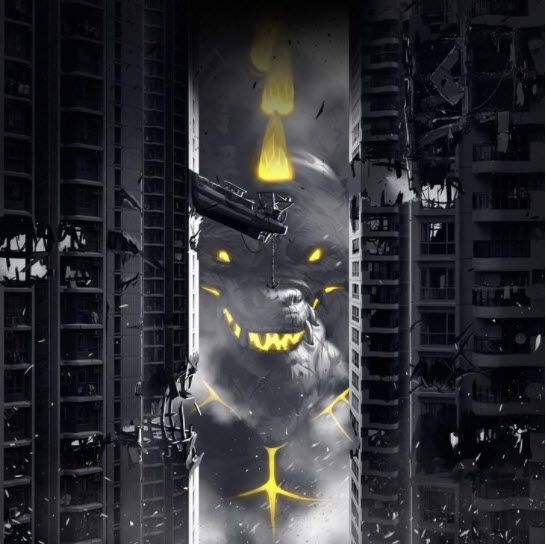King of Tokyo is a game published by IELLO games. The game premise surrounds monsters invading Tokyo, each attempting to conquer it. The game mimics the Kaiju inspired movie genre and includes cool graphics and oversized dice. The first player to reach 20 victory points is declared the winner! There are several ways to gain victory points, but it is important to remember other players affect your health and can knock you out of the game if you aren't careful!
This post is broken into the following 3 sections, feel free to jump directly to one:
- General summary - consisting of information about overall enjoyment, theme, replayability, and upgrades
- Complexity - consisting of information about the rulebook, setup, player turns, and overall learning curve
- Player turns - consisting of game type, game flow, rule you are likely to miss, and favorite aspect
General Summary
Number of players we had: 3
Our play time (not including setup): 35 minutes
Quick note about the King of Tokyo game: there are tens of versions of this game, so if you are interested in trying it out, there will likely be a theme you connect with. We lucked into buying the Dark Edition and we love everything about it - from the dark dice to the velvety box cover. Also, the wickedness elements are unique to this version, or at least do not exist in all versions (we have not played them all), so keep this in mind when reading the review and considering purchasing or playing this game.
Overall enjoyment

There are several things our group likes about this game, including:
- The monsters are extremely detailed so you get sucked into the theme right away.
- The dice are quite large, making all sides easy to see for all players. They also have a little weight to them which lends to the theme of causing destruction. Lastly, the images on the dice are unique with hearts, numbers, energy charges and handprints for wounds.
- Play is fast and things can change very quickly making it interesting and engaging. There is no time to get bored with this game.
- A group of players can play as aggressively or passively as they want and the game play will be different based on these choices.
At its heart, this is a dice game that includes some luck, some card drafting, and some strategy. It also adapts nicely to the number of players, which makes it fun regardless of your number of players.
If there was something that could be frustrating about this game, it would be your luck, or lack thereof, with dice rolling. Some people are always going to be luckier than others, thankfully, there are other mechanisms in play so even unlucky dice rollers will impact the game.
Also, when we first opened our game, to our surprise the deck of power cards was in French! Even playing using a translator app, because we really wanted to play our new game, it was too frustrating. However, once we contacted support, we were quickly mailed the correct deck without any hassles so hooray for customer support!
Theme

I have already mentioned how much we enjoy the theme, we especially like the darker board, dice and the detail in the player pieces. However, this is a fairly simple game, the board is small - without a need to be larger or more complex. Also, the game pieces are cardboard that you stick into stands, not miniatures. Having said that, the pieces are sturdier than many and we have not had any issues with the pieces getting damaged being placed in and out of the stands.
Replayability

This is a very subjective measure, but if you like quick games with a decent amount of action, you will replay this one often. It is not an overwhelming game, but it moves fast and things can change quickly. We tend to like that, in games with long delays I personally find my mind wandering, but that does not happen with this game.
Also, there are 66 power cards and we never make it through even ½ of the deck, which means it takes several plays to even see most of the cards. Also, there are 10 double-sided randomly placed wickeness tiles that provide all sorts of upgrades that can instantly change the game.
Upgrades
There are add-ons for the King of Tokyo game in general, not sure if there are any specifically for the Dark Edition as we don't feel the game needs it. However, and this is a quirk of mine so keep that in mind, the game comes standard with an insert that has a perfect place for every game piece which feels like an upgrade!
Complexity
Rulebook
The rulebook is short which goes along with a game that is not difficult to learn and begin playing. It is also organized and I appreciate that instead of simply explaining the rules, the rulebook uses the corresponding game symbols wherever possible. This makes it so much easier to know exactly what is meant and develops a greater understanding when using game pieces. There are also several examples of game play in pop-out boxes so they are easy to find and easy to follow.
Setup
Game setup is very straightforward and can be done in 5-10 minutes once you know how to play. This makes it a great game for an impromptu game night or to get the game night rolling.
Turns
Player turns go very quickly in this game. The active player rolls six dice up to three times to an effort to get the best "hand". After resolving the dice, which is pretty quick, the player can choose to buy cards with their energy charges. If a player earns a new wickedness tile, the game can move on to the next player while that player chooses. Also, because wounds rolled are delivered to other players, everyone is paying attention to each other's rolls. This means the game engages players even when it is not their turn.
Overall learning curve
This game is deceivingly easy to play. However, its complexity can sneak up on you. The game mechanics are quite simple and straightforward, but the wickedness tiles and power cards add lots of facets to a player's turn and abilities. Once a few players have wickedness tiles and/or power cards, the game play ramps up. Luckily, these take time to earn, and by then most players will be adept at game play.
The only other thing worth mentioning is that there are slightly different rules for the player/monster in Tokyo versus those players outside of Tokyo. Still, there is a small key on the board as a reminder of those rules and the differences are not overly complex or complicated.
Player Turns
Play type
This is a competitive game that can be played moderately or highly competitively depending upon the players and how they go about their turns. For instance, if players decide to focus on wounds and keep all those rolled, other players will lose life points and you only start with 10. This means players will need to roll hearts to stay in the game. On the contrary, if players choose to reroll wounds, hoping to advance their game in other ways, players will have more time to gain energy charges, cards, and wickedness tiles.
Game flow
Turns are quick, with only a few phases and things change quickly so the game flow is fluid and fast-paced.

Rule you are likely to forget
There are not too many rules in this game, however, the one thing we found players getting hung up on was how to resolve the dice. When you roll three of any number, you get a total of three "reward points" that are split between victory points and wickedness points. The amount of victory points is equal to the number on the triplicate dice, while the wickedness points are what is left after the victory points are subtracted from three. This means if you rolled three 3s, you will not get any wickedness points. Also, don't forget to give two victory points to the player in Tokyo when their turn begins.
Favorite aspect
One of my favorite aspects about this game is the rules for rolling the dice. I love that you can roll your first time, set some dice aside, roll your second time, then decide to roll any dice on the third roll even if they had been set aside previously. This provides for maximum flexibility and adaptability based on what dice you rolled and I think it provides a richer game experience.
Everyone in our group likes the size of the dice which are quite a bit larger than most playing dice. The coloring on the dice also makes it very easy to see what you have rolled. Lastly, the game moves fast! While you may be ahead when your turn ended, you could get knocked out of the game before your next turn if you aren't playing a balanced game. This makes the game more interesting and forces all players to be paying close attention at all times.
Overall we definitely like the aesthetics of this game, the oversized dice, and the detail paid to the cards and monsters. We also like that anyone can win and things can change quickly so no one player ever feels too far behind. This is a great fast game to play with just about any crowd.


